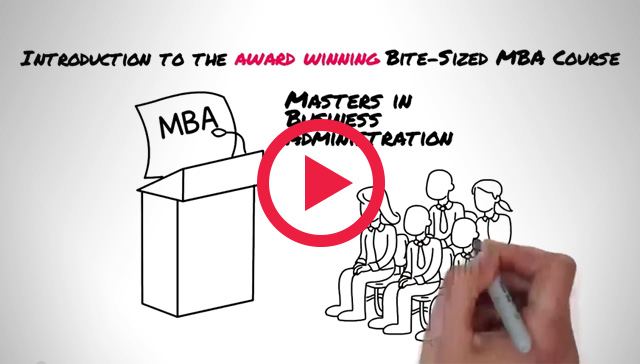An Introduction to the award winning Bite-Sized MBA Course
Go to Video 1.1 and the Online Course What you will learn on the Online CourseWatch Video 1.1 For Free
Enter your email address to sign-up to our free newsletter and watch the first video for free
Secure full access to the entire course now
Get StartedMBA Modules
Click on the MBA modules below for more details
-

Module 1 - The Industry Layer
Videos 1.1-1.6How to identify the critical factors for success within any industry.
-

Module 2 - The Internal Layer
Videos 2.1-2.7How to select and execute the best strategies for your business.
-

Module 3 - The General Layer
Videos 3.1-3.7How to interpret and respond to change based upon your unique strengths.
The 7 steps of Developing Strategy
You will learn how to..
Identify the critical factors for success within your industry (Module 1)
Before it is possible to develop the best strategies for a business, we must understand the key factors that determine profitability within its industry. Therefore, carrying out an industry analysis is always the first step we go through when developing the strategy for any business. In Videos 1.2 - 1.6 (of Module 1) you learn how to very quickly and easily analyse any industry. This is Step 1.
Draw a Strategy Canvas to reveal your business’s unique identity (Module 2)
Every business must be able to answer the fundamental question “Why are our customers buying from us and not from our competitors?” It must be doing something recognised as being in some way unique or superior to the competition, which is important to its target customers. This can be diagrammatically represented by drawing a Strategy Canvas. In Video 2.4 (of Module 2) you will learn how to draw a Strategy Canvas for your business. This is Step 2.
Select the best strategies for your business (Module 2)
There exists a list of predefined strategies (assembled by leading academics) that have been designed to improve profitability. These can be found at Exercise 2 Worksheet 2. The strategies that are most appropriate for a business should be governed both by it understanding of its industry forces (revealed at Step 1) and by its unique identity (revealed at Step 2). In Video 2.5 (of Module 2) you will learn how to select strategies from the predefined lists. This is Step 3.
Execute the strategies that you have selected (Module 2)
It is only having selected those strategies that are best for a business (at Step 3) that we can identify the key assets that will need to be in place in order to execute those strategies. This can be expressed graphically by drawing a Key Asset Map. In Videos 2.6 and 2.7 (of Module 2) you will not only learn how you can draw a Key Asset Map for your business but also how you can put those key assets in place through the use of Functional Strategies. This is Step 4.
Interpret change within your market (Module 3)
If the world never changed a business could continue to pursue exactly the same set of strategies (as defined in Steps 1 - 4) indefinitely. However, the world does change and therefore a business cannot rely on past success to carry it into the future forever. Consequently, a business needs to understand how to interpret change from a strategic perspective. This can be achieved by using the Future 5 Forces Model and the Future Brand Identity Model. Videos 3.1 - 3.4 (of Module 3) will help you learn how to use these models. This is Step 5.
Respond to that change in a superior manner to the competition (Module 3)
Having understood how to interpret change (at Step 5), Step 6 encourages the business to ask itself how it can respond to that change in a manner that is superior to the competition based upon its unique set of strengths. Because no two businesses are alike, no two businesses should respond in the same way to a change within its market. This is referred to as the Resource Based View of Change. In Video 3.5 (of Module 3) your will learn how to respond to change. This is Step 6.
Discover where your ‘sweet spot of opportunity’ lies (Module 3)
To succeed in the long term a business must be able to create an inner urge for progress and identify new markets where it can exploit its existing set of strengths. To achieve this it should pursue those opportunities that allow it to reveal and enhance its existing capabilities. This can be revealed through the use of a framework entitled the Sweet Spot of Opportunity. In Video 3.6 (of Module 3) you will learn how to discover where your Sweet Spot of Opportunity lies. This is Step 7.
Business Education for Professionals More info





